Ellen and Jim Have a Blog, Too
We are two part-time academics. Ellen teaches in the English department and Jim in the IT program at George Mason University.


Pallisers 8:15: Mourning and aging, political thought in _Phineas Redux_ (1) · 30 September 08
Dear Friends,
I continue with the 1974 BBC Palliser films. I place Raven & Wilson’s 8:15 in the series, discuss its central themes and moods, and compare these to what we find in Trollope’s Phineas Redux.
As did Pallisers Parts 5:9 (“Time is pressing us very hard, Mr Finn” and 5:10 (“A double life’) so Part 8:15, stands out as a gem of televisual art. As 7:14 was so disparate & pulled together by dramatic scenes, this one is all of a piece, mournful, dark, the themes cohering within the part and as a turning point for the Pallisers (who become Duke and Duchess) in the series.
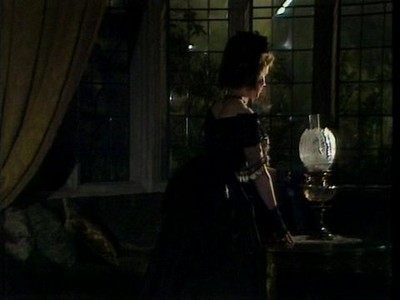
In the “a picture is worth a thousand words” department, we see Lady Glen (Susan Hampshire) now Duchess musing at a window at what her life has been and what she has to look forward to. The mise-en-scene transcends the context.
I’ve discovered another sign of moving onto another level of achievement is the use of original illustrations for mise-en-scene. (This was done in the 2001 The Way We Live Now, which I will eventually study and write about; we see it in film adaptations of Dickens.) Well, in another masterly part, 3:5 when Planagenet (Philip Latham) goes walking in the streets, remembers Lady Glencora’s agonized words (in a rare use of voice-over in the series) and thinks about whether he should give up the Exechequer in order to go away with Lady Glen and make his marriage work, he is pushed into the decision he was leaning towards by George Vavasour who tells Plantagenet he must “fix his house first.” Simon Raven and Hugh David modelled the scene (blocking, costumes, gestures) on illustrations by George Housman Thomas (from Last Chronicle of Barset) of Josiah Crawley who also listens to what he wants to hear when a poor parishioner tells him “Dogged as does it.”
Now Lady Glencora (Susan Hampshire) and Marie Goesler (Barbara Murray) are dressed as the Marchioness of Auld-Rickie, the Countess of Midlothian, and Lady Hartletop were in the opening episodes (1:1 to 2:3): they are in heavy Victorian mourning outfits meant to conjure up Queen Victoria. In their intense support of and communing with one another:
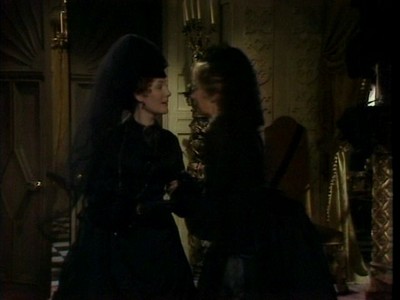
their gestures and posturing recall Millais’s illustrations for Orley Farm depicting the loving friendship of Mary, Lady Mason and Mrs Orme:
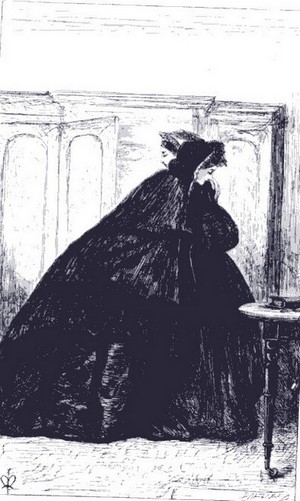
Mrs Orme and Mary Lady Mason say goodbye, Orley Farm (by J.E.Millais)
So what is the matter of this part? aching heart-break and loneliness is the lot of Laura (Anna Massey) and Robert Kennedy (Derek Godfrey), of (surprizingly, perhaps) Lady Hartletop (played by a different actress, Doris Rogers, from the actress who appeared in 1:1, Edith Saville), of Marie Goesler whose hopes are waning. Laura Kennedy is bereft unendingly, for Phineas (Donal McCann) does not love her as too much time and many life-changing events have passed, including his marriage which is taken into account in McCann’s acting in a way it’s not in Trollope’s book. Robert Kennedy is half-crazed. The Duke (Ronald Culver) dies in scenes whose emotionalism is laced with a stringent bitterness. There is comic disappointment too: no one wants to listen to 2 and 3/4s hour of a speech of Plantagenet showing how much benefit the “country” would gain from decimalization.
Everyone is aging too: now the growing three children (Nicholas Scrivner, Andrew Tinney, Heather Garrison) of Lady Glencora and Plantagenet Palliser are bought on stage as separate personalities in an invented funeral scene where we returned to the church where Palliser and Lady Glen were married, and from which they (with Alice Vavasour, Caroline Mortimer, and John Grey, Bernard Brown) emerged with the new baby-heir (Silverbridge that is to be, as a new born); we are passing by the place Lady Glen will be buried in and which the Duke will stare out at from the Matching Priory windows in 12:26.
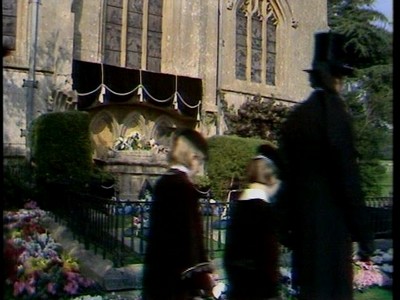
New Duke (Philip Latham) with sons at funeral
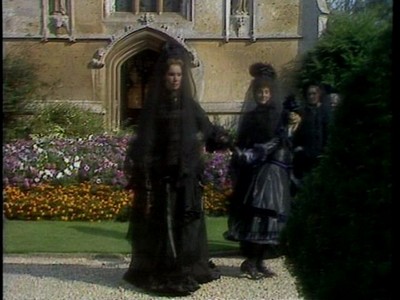
Lady Glen as Duchess (Susan Hampshire) with Lady Mary, Marie just behind
Everyone seems regretful and disappointed. Phineas is beset precisely because he wants to do the moral decent thing in politics and private life. Lady Glencora and Plantagenet Palliser regretfully become Duke and Duchess in a scene which brings them together in shared sympathy (a new turn we have not quite seen before but will increasingly as they come into conflict in the matter of The Prime Minister):
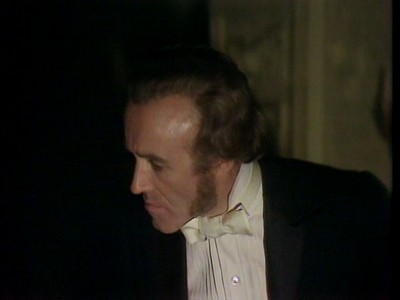
He would avoid being duke if he could. He turns away physically from it. Will not make eye-contact.
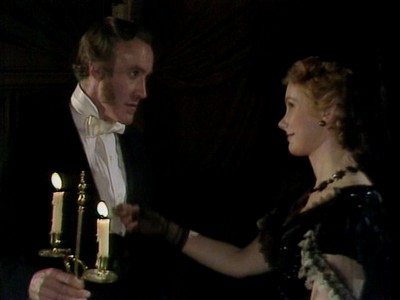
She doesn’t mind, and affectionately calls him “Your Grace” for the first time; she smiles gently and makes a tender gesture with her hand
Trollope’s Phineas Redux is partly structured around Phineas and Laura Kennedy: the opening and close of Trollope’s novel are given over to powerful scenes between these two (at Dresden, the long walk and passionate embrace on the ramparts of Konisberg, and then the night-long walk and adieu at Saulsby) and inbetween we get a (as it were) inset epistolary novel as the two of them exchange long letters over the course of the novel until Laura comes to London and Phineas is imprisoned. At the close of the novel, Trollope made Phineas hesitate and say no to the Prime Minister’s offer of his old job at the colonies partly so that Trollope could bring Lady Laura back at the end of the book as Phineas’s advisor as she’s been the secondary heroine of the Phineas books, not Madame Max.
In Trollope’s novel structurally and for much of the novel’s space, Madame Max is kept to the side; she goes to Harrington Hall, is courted by Mr Maule and sees Phineas as his friend and a society hostess, and then friend to Lady Glencora (then the Duchess) part of the crime-solving plot-design and the Duke’s death scenes but these are not pivotal to Phineas’s fate which is what gives the novel its structure; she becomes pivotal to Phineas’s fate when she sends back the key, but note we are not shown her quest, only told about it, and when Phineas finally proposes we are given the shortest of (sweet) scenes as opposed to all the long ones in Trollope PF. (By contrast, in Gaskell’s Mary Barton we are shown Mary Barton’s quest to save her hero.)
Now in Raven’s films in across the series, and in 8:15 in particular Marie is made pivotal, with Laura from an overall perspective a secondary character who is dismissed from the stage well before the end of the series. In the Palliser films Plantagenet and Lady Glencora are more centrally pivotal figures in the film episodes in which they are central than in Trollope’s books (CYFH and Prime Minister): their coerced match, married and political life together are the bones of the plot-design of the 26 parts so when Madame Max is made an important part of this matter, with the Duke kept to the fore in the Eustace Diamonds material, all you need do is keep her presence in these scenes to keep her central. And that’s just what is done in 8:15. She is brought in with the Pallisers immediately after Phineas’s visit to Kennedy and then Laura; she is the close intimate friend of Lady Glencora:
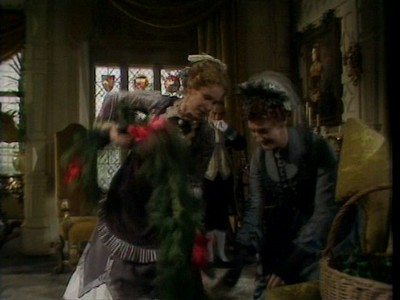
Lady Glen and Marie intimate friends
In the films, Marie is there at the Duke’s death (fully dramatized, two scenes in 2 chapters are milked several times for scenes here) and then the part closes on her yearning for love, even if the emblem shows us Lady Laura in grey reading Phineas’s letter about Slide’s (Clifford Rose) coming possible exposure of her and him.
I suggest this part is structured around two couples: Phineas and Marie on the one hand (though not together, their presence and stories are now running parallel again) and the Duke and Duchess. As I’ve written before, Marie Goesler as a movie or TV type corresponds to the superfemale Molly Haskell first identified as an ideal type of women in European films. The superfemale is someone who doesn’t marry or doesn’t get her power from marriage but is seen to be powerful, and utterly feminine; she is sexual and yet not to be used by just anyone, a user of sophisticated mores to manipulate, highly theatrical in her self-presentation, but ever quiet (this is a man’s ideal), not obviously aggressive (ditto), flirting in an intellectual interesting way, and beautiful, fine fashion. Independent, child-free, not ambitious for a public role, indeed preferring to keep out of the limelight as dangerous to her fulfillment and self-respect.
By contrast, Laura’s role corresponds to the woman careerist, in American films, the superwoman, here who mistook her era and ability to withstand custom and law to carry it off—though what is emphasized in this part is the loss of love, how Laura has become a lonely ostracized outsider.
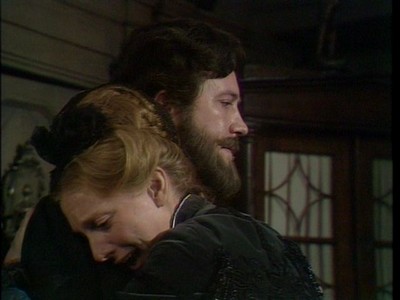
Phineas (Donal McCann) and Laura (Anna Massey) embrace once more, she in love, he no longer
Meanwhile Madame Max is presented as still an outsider and must tread very carefully or she will end up ostracized; in this film after the Duke’s death, Palliser asks Lady Glen if she will drop Madame Max; he is pleased she will not, but if she had decided to, he would have said nothing.
In several scenes as the politics of this sequence builds up, we see how Lady Laura has been bad news for Phineas. By contrast in the book and also these films Violet Effingham having given up her body and soul to Chiltern is good news for Phineas and Chiltern; we hear of Lady Chiltern now only through her pregnancies, support of Phineas, invitations, and Chiltern’s desire to hunt foxes which links them to the Palliser group and makes a comic problem Lady Glen will have to fix for him. Plantagenet cares not for such trivia, and if he looked into it, he would probably disapprove.
Phineas’s enemies are intertwined with his relationship with Laura. There’s the violent Kennedy: Kennedy tries to kill Phineas (another man trying to kill Phineas over a woman; Chiltern was first); and the insidious Slide who acts out the hypocrisies of newspapers and the envious Bonteen (Peter Sallis) who can use Phineas’s decency towards Lady Laura and political conscience to destroy Phineas. Bonteen’s detestation of Finn is well motivated in the film as Laura’s cousin, Barrington Erle’s (Moray Watson) is. Slide too especially detests any man who has principles, and also anyone who wants to help someone who is bad news. Barrington is a party man, an instrument.
Towards the end of this part Dolly Longstaffe (Donald Pickering), the series’ cynic, begins to appear again as the more explicitly political matter (debates in parliament on the disestablishment of the church) is also alluded to.
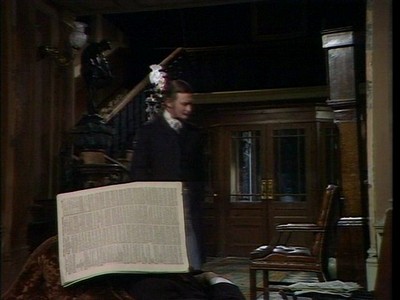
Dolly Longstaffe trying to get through a Sunday
Phineas’s second problem is his conscience: even if ethical, Plantagenet will not sympathize with Phineas’ brand of individual idealism. This does cohere with Trollope’s analysis of politics in the book, which I take a little time to review here.
By way of comparison and to acknowledge Trollope’s achievement, I’m going to switch briefly to talk just of Trollope’s Phineas Redux’s serious political meditations (none of which make it into 8:15). Trollope has Erle present a really brilliant justification for voting with one’s party: the argument is if people don’t do this, what will result is a dictatorship with individuals who get high in the cliques imposing their narrow views; if you have a party where all must agree, that is a constraint. Trollope’s New Zealander shows he saw governments are oligarchies supported by military might run by cliques, and this kind of analysis is prophetic of what we see today. Then Trollope’s Phineas replies and we see he sees Erle’s analysis as rather supporting families in power and the Whig-Tory partriarchy. Erle answers, well, yes, in part and he is not ashamed of this as he sees these cliques as genuinely educated to produce a good outcome for “the country.” An ambiguous phrase which then meant those in charge (owners) and men who voted (a small number of people), but he probably thinks their interest is that of others.
There’s Trollope’s remarkable candour when he describes how churchman supported by the state are very like cab drivers or letter-carriers (which he had been) or barristers: how rare it is for someone in a profession to think it’s not superimportant to the society. He also shows how the lack of an adequate income for a clergyman can make him despised and not wanted by his parishioners. How also the average person who might believe in the religion might not like the particular indivduals he is told to go to who have local power.
The novel has a continual serious delving into abstract and general principles of politics as well as issues of the day: to go at religion this way is worth remark, and something few are willing to talk about Trollope having done. This links the book up to books like Trollope’s The Bertrams where church doctrine are questioned as well as the many books critiquing the corrupt way offices are handed out.
Trollope’s Maule (eliminated by Raven) is a stunning refutation of Erle’s argument for the value of good education (admittedly Maule is not in government), or any idea Trollope had something invested in gentlemanliness for itself and was not sympathetic to real commerce. The real hero of The Claverings is a civil engineer, brother to Florence Burden.
On the church politics, in Trollope’s Chapter 32 we see how hypocritically Daubeny uses the issue, which since Raven has no narrator he must limit to each character talking from the limited point of view of his desire for power or the party’s needs (Erle, Bonteen also jealous and spiteful, Palliser). Still, why not have been daring? The 1972 Golden Bowl was brilliant because it had a narrator. Arguably if anyone wanted seriously to make a great film from a Trollope novel the first thing they should insist on would be much voice-over or better yet (to make the lines not tied to a character where it becomes unreal or pompous) the use of an unassigned narrator like Woody Allen uses :).
In short, how different is the source of dark mood in this part from the book it’s adapting. The source of the saturnine mood of Trollope’s book is his presentation of corrupt, useless, irrational non-progress politics. Nowhere is Trollope’s Phineas Redux filled with grief as such, nor a sense of deep aging, because in Trollope the actual death of the duke is not dramatized and passed over in favor of how it affects the living. Phineas becomes understandably depressed in the last portion and we see him overcome his permanent disillusionment and resolve to soldier on—on his own terms now that he marries money. A true Trollope hero he does marry money (and someone he has learned to esteem, be grateful to and thus love).
Interestingly then, Pallisers 8:15 is a kind of transition for the whole series: everywhere it’s emphasized how the youngish characters we started out with are aging, growing weary, tired, desperate (Phineas, Lady Laura, Lady Glen a little, Madame Max too), and except for Palliser disillusioned or corrupt. We are moving into the second half of the series and now Palliser is the central Top Male male—and instead of a unchanging stance and symbol at say parties and dinners, we have a hard working politician who bends to the winds of the moment.
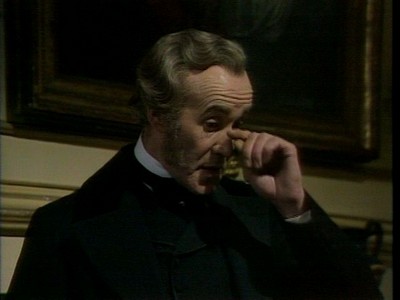
Palliser planning with other politicians (Barrington Erle, Mr Bonteen)
It would seem this is not a fundamentally comic series; Jim says the Phineas books are fundamentally tragic. Had Trollope not altered Lady Glen after CYFH? and left Madame Max a demi-monde, and allowed her to become the mistress of Phineas, the hard elements of the top love story would have had much more play; as it is, it’s a story of loss and regret for Plantagenet in Trollope and Raven, with the new generation in the film bringing in change and hope again. Not so much the book where human nature doesn’t change. I wish we had the uncut Duke’s Children :) (See the summary of Stephen Armanack’s first paper).
Next time a concise summary and commentary on the individual episodes.
Ellen
See various links and a concise summary of 1:1-3:6, 4:7, 4:8, 5:9, 5:10, 6:11, 6:12, 7:13, and 7:14.
--
Posted by: Ellen
* * *
Comment
- From Nick:
“Ellen has noted how the episodes vary widely in quality; I would wholly concur with this perspective.
Episode 15 was, for me, most definitely the high-point of the series so far. It was dominated by two beautifully written, directed and acted scenes: that where Laura and Phineas meet again and Laura opens her heart, and the second Omnium’s death-bed (a scene between Madam Max and Omnium).
Of these it is interesting that I felt the first to be very Trollopian. Laura is here an epitome of certain Trollopian characters (Caroline Waddington springs to mind as the Bertrams is fresh in my memory) – the woman who makes the terrible (for Trollope) mistake of putting money/status/power before love. I don’t here want to examine the ideology behind this, which we can do passim as far as Trollope is concerned :), but just note how beautifully Anna Massey ‘realised’ this in this particular scene.
The deathbed scene is another matter. Here it is in Trollope…
>>A clergyman attended him, and gave him the sacrament. He took it—as the champagne prescribed by Sir Omicron, or the few mouthfuls of chicken broth which were administered to him by the old lady with the smart cap; but it may be doubted whether he thought much more of the one remedy than of the other. He knew that he had lived, and that the thing was done. His courage never failed him. As to the future, he neither feared much nor hoped much; but was, unconsciously, supported by a general trust in the goodness and the greatness of the God who had made him what he was. “It is nearly done now, Marie,” he said to Madame Goesler one evening. She only pressed his hand in answer. His condition was too well understood between them to allow of her speaking to him of any possible recovery. “It has been a great comfort to me that I have known you,” he said.
“Oh no!”
“A great comfort—only I wish it had been sooner. I could have talked to you about things which I never did talk of to anyone. I wonder why I should have been a duke, and another man a servant.”
“God Almighty ordained such difference.”
“I’m afraid I have not done it well—but I have tried; indeed I have tried.” Then she told him he had ever lived as a great nobleman ought to live. And, after a fashion, she herself believed what she was saying. Nevertheless, her nature was much nobler than his; and she knew that no man should dare to live idly as the Duke had lived.>a general trust in the goodness and the greatness of the God who had made him what he was >shows Kennedy to have become deranged by religion. I doubt anyone would dare today present religion in this way.
— Elinor Sep 30, 11:03pm # - Yes it’s not surprizing that in the archives there are men willing to become founders of the Madame Max club. Last night I managed to begin to return to my Pallisers project, and rewatched 8:15. I did find too that Tim’s idea that Madame Max loves the Duke is in this film. It’s not in the book. She respects, she values, she “appreciates” him in the book, but no word of intense love. This is the film; it’s sentimental and pop for popular culture, an overemotionalism Trollope does not indulge in. Also her overt longing for love, to give herself to Phineas is not in the book; we are left to imagine the nature of her love; we are to see: this is a contrast and comparison to Lady Laura, but again her regrets are placed early and partly about the time spent with the Duke, and what she wants is not explicit in the novel, not voiced in this way, only that she won’t give herself to such as Mr Maule (a drone); she wants someone with a genuine ethical purpose.
A middle class ideal is replacing the aristocratic one here, and Raven knows it. The last episode will show the new Duke allowing his children to marry for love as he and Lady Glen were not. .
I don’t fault the series for being different at all, only that unless you pay attention, you may not catch it and then people attribute to Trollope’s book what is in the films. Trollope is insistent that Phineas is innocent of the murder and that we know this—so as to emphasize the pain of his seeing how people don’t value him for what he is, don’t care about it, don’t really understand him, and are willing to think horrible things of hiim as they don’t think or feel deeply. In the film Raven takes the view it’s natural to suspect Phineas, he takes a coarse view and accepts suspicion and the idea Phineas could have done it, so the depression Phineas feel in PR which has metaphysical implications is erased away.
Raven cares nothing for depressed characters. He erased this in Alice Vavasour too.
Trollope is enormously rich. You can read and reread and each time more and different passages come up to you and hit you in the soul or thought. In my view he’s one of the great novelists of the English language—as Austen’s Mansfield Park is one of the great novels. I bring MP up because I’m struck with how the underlying point of view in MP when it comes to judging Maule and his friends, as well as Maule junior, is just that the narrator of MP: struggle, endure, and work for others and yourself is a salvation; it’s in those terms in the book Madame Max makes a final strong statement against the Duke’s life.
The satire on politics is savage and it's here we see why people say Trollope loathed Disraeli. Disestablishment stands for other things the conservatives did which were supposedly against their beliefs, but which they did to keep themselves in power. The whole of this part of the novel reminds me of Bleak House where the male narrator takes over and is as strong and true to real ethics and exposes society as any Swift.
What I wish is Trollope had not erased the sexuality of the earlier woman character of CYFH?, the woman who had had two husbands, was paying one to stay away, who was cosmopolitan in her outlook fully as well as politically radical. We have exchanged her for an olive skinnned chaste youngish woman in the book who is in love with Phineas; in the films we have our European femme fatale in a mid-life crisis :).
E.M
— Elinor Sep 30, 11:04pm # - This episode is replete with Lady Glen and Marie’s friendship, many stills, dialogues, interwoven in the themes. I suppose this is most unlike the whole feel of Phineas Redux though the textual authority for it is there.
E.M.
— Elinor Oct 1, 6:56am #
commenting closed for this article
